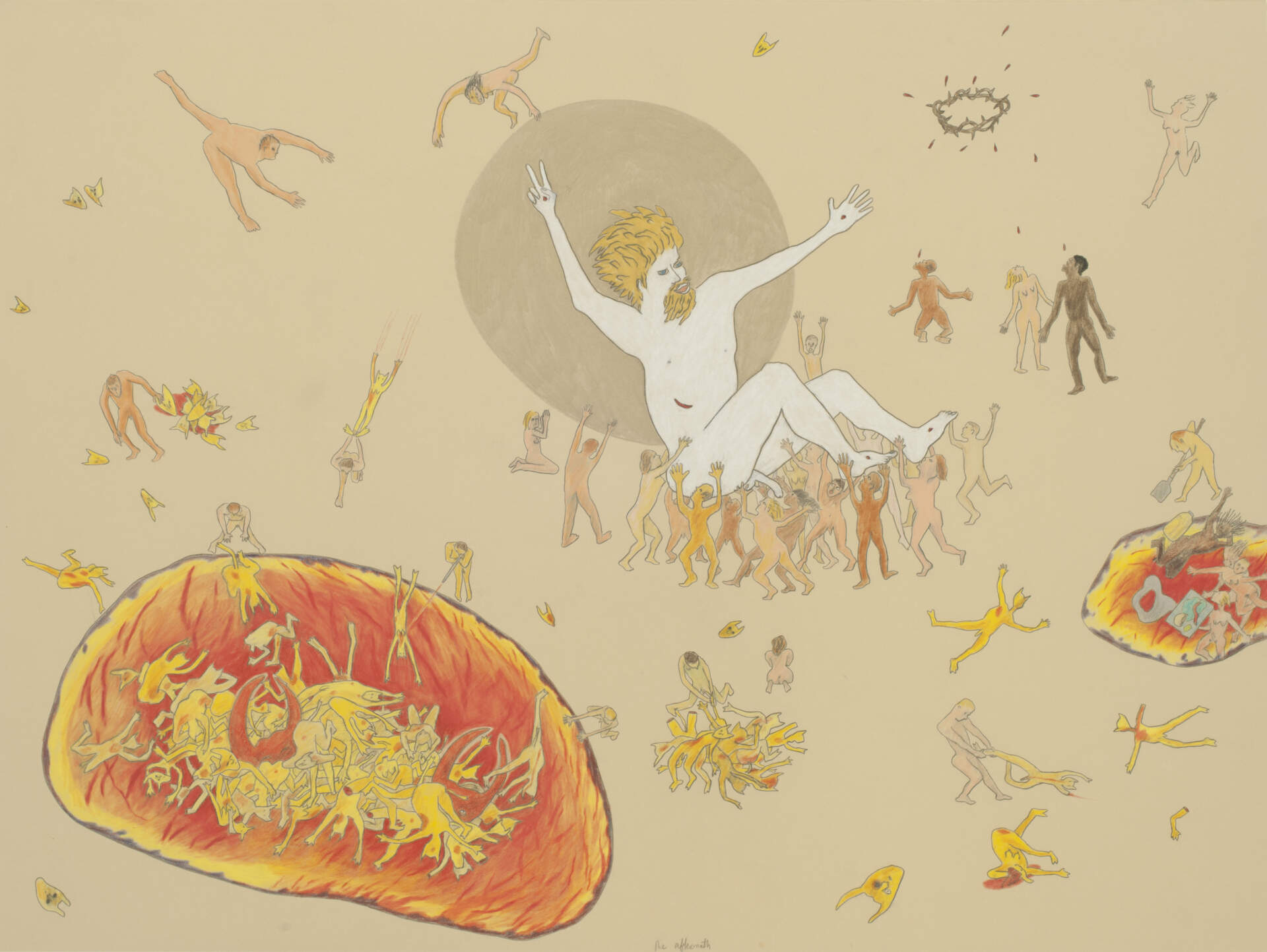
David Schirm (b. 1945), The Aftermath (from the series The Rapture), 1991; mixed media on paper, 22 3/8 x 30 1/8 inches; Courtesy of the Artist
Angels and Demons: Works on Paper by David Schirm
Past
Dec 8, 2017 - Mar 25, 2018
Angels and Demons: Works on Paper by David Schirm is an exhibition about violence. Schirm, painting professor at the State University of New York at Buffalo since 1985, is a veteran of the Vietnam War. After receiving his Bachelor of Fine Arts degree from the Carnegie Institute of Technology (now Carnegie Melon University) in 1967, he enlisted in the United States Army, hoping to “direct his participation away from combat into something positive.[1]” He received his Master of Fine Arts degree in painting from Indiana University in 1972.
This exhibition focuses on work by the artist from the decades that followed his experience in Vietnam. We Must Not Do This to One Another from 1983 is a direct reference to war. Nude figures face off in a scene reminiscent of renaissance artist Antonio Pollaiuolo’s Battle of the Nudes, ca. 1465-1475[2]. Cut pink bodies, disfigured and grimacing fill the page. Weapons are wielded by figures who stand in opposition and behind other figures. Two central bodies, holding handguns, bring to mind the iconic Pulitzer Prize winning photograph by Eddie Adams, General Nguyễn Ngọc Loan executing a Vietcong prisoner, Nguyễn Văn Lém, on a Saigon street.
Home Town Tune, also from 1983 is about a different kind of violence. Three figures cross the composition, each with their internal organs exposed, showing quite clearly that their lungs are turning black. The work was made as a reaction to the Hawk’s Nest tunnel disaster, the worst industrial disaster in U.S. history. The tunnel was built, starting in 1930, as part of a hydroelectric project on the New River in West Virginia. During the excavation silica rock dust caused the death of almost five hundred workers by silicosis.
Schirm’s Rapture series from 1991 tells the story of the “war in heaven[3]” from the book of revelations or the rapture, in the Christian Bible. This epic battle between good and evil, a common theme in renaissance art, is here simplified and given a graphic comic quality. In the fourth scene from the series, a very white and very blonde Jesus is carried off like a football star by his adoring fans.
Another work from the same year, Have a Nice Parade, is a commentary on the civilian death toll in Iraq during the Gulf War also known as Operation Desert Storm. In 1983, the American invasion of Grenada was censored, with the U.S. government denying access to the press. By 1991 media coverage of U.S military actions had evolved, with similar restrictions forcing journalist to participate in “pools,” which would be imbedded with military personal. Coverage of that war was generally reduced to areal film and photographs of bombing raids, which substitute “the “hard” targets of weaponry, machinery, and buildings for the soft targets of Iraqi and Kuwaiti casualties.[4]”
72 Virgins from 2004 is the most recent work in the exhibition. This piece was created shortly after the beginning of the Iraq War, the U.S. Military’s second incursion the country in less than two decades. A suicide bomber has blown himself up, with body parts scattered across the composition. These fragment of the presumed insurgent are the only parts of the picture articulated in color. The seventy two virgins, drawn in ink alone, are checked off at the bottom of the piece like points on a score card.
[1] Thomas, C. D. As seen by both sides: American and Vietnamese artists look at the war; Indochina arts project ...Boston, MA, 1991. pg. 62
[2] Lippard, Lucy R. A different war: Vietnam in art. Bellingham, WA: Whatcom Museum of History and Art, 1990. pg. 81
[3] Revelation 12:7-13 King James Version (KJV)
[4] Chong, Sylvia Shine Huey. The Oriental obscene: violence and racial fantasies in the Vietnam era. Durham: Duke University Press, 2012. pg. 4